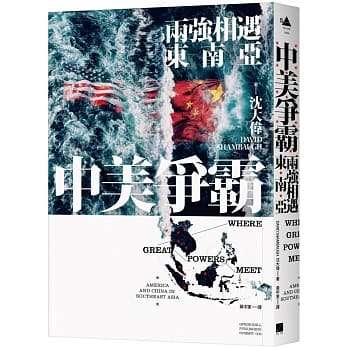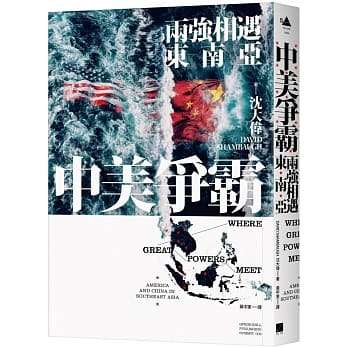US-China rivalry: The two powers meet in Southeast Asia
US-China rivalry: The two powers meet in Southeast Asia
In stock
Couldn't load pickup availability
出版社: 春山出版
ISBN/EAN: 9789860670660
出版日期: 2021-09-07
页数: 464页
语言: Traditional Chinese
Where will the US-China relationship in the 21st century take the world?
China's rise and the United States' decline, is this the current situation, the future, or just a propaganda exercise?
To find out, please follow the author to the epitome of the competition between the two powers: Southeast Asia.
The world order of the 21st century will likely be determined by the outcome of the US-China competition. Has a new Cold War arrived? Is the future of China's rise and America's decline truly what we face?
In response to the above-mentioned issues that many readers are concerned about (worried about), the author of this book, David Shambaugh, focuses on the competition between the United States and China in Southeast Asia, and combines field visits, objective data and literature research to provide his insightful answers in profound analysis.
David Shambaugh believes that the battle between the US and China for dominance and influence is unfolding worldwide, with Southeast Asia at its epicenter. The US-China confrontation in this region is a microcosm of the global rivalry between the two superpowers. Therefore, understanding the US-China game in Southeast Asia provides a comprehensive overview of the entire situation.
In this book, the renowned American scholar and government advisor on China and Asian affairs, using concise and accessible language, paints a richly detailed, panoramic scroll spanning time and space. Readers can unpack the historical engagement, current relations, and future directions of the three actors involved: the United States, China, and Southeast Asia.
The author first provides an overview of the US-China competition in Southeast Asia, challenging the stereotypical dichotomy between the US relying on hard military power and China on soft economic power. He then traces the histories of interaction between the US and Southeast Asia, and between China and Southeast Asia, respectively, and outlines the contemporary international political consequences of these historical foreshadowings. The second half shifts to a Southeast Asian perspective (a distinctive feature of this book), examining how the ten ASEAN countries are maneuvering between the two powers. Finally, he predicts the likely developments in this geopolitical drama between the US, China, and Southeast Asia.
Geographically, Southeast Asia is Taiwan's neighbor, with whom we enjoy close economic and trade ties and frequent population interaction. In recent years, the government has vigorously promoted the "New Southbound Policy" in an effort to deepen these connections. Geopolitically, Southeast Asia is a crucial battleground in the rivalry between the two superpowers, and Taiwan is also on the front lines of the US-China rivalry. Therefore, while this book discusses Southeast Asia and US-China relations, its topics are also deeply relevant to Taiwan, making it worthy of careful reading and a useful reference.
David Shambaugh
Professor of Asian Studies, Political Science, and International Affairs at the Elliott School of International Affairs at George Washington University, and Director of the China Policy Program, is internationally recognized as an authority on contemporary China and Asian international relations, earning him the nicknames "China Hand" and "Asia Hand." He has authored and edited numerous books, including this book, The Future of China (2018), which was translated and published in Taiwan.
Huang Zhongxian
A graduate of the Department of Diplomacy at National Chengchi University, he is a full-time translator. His translations include The Great Divergence by Ken Pomeranz, the Mongol Empire trilogy by Jack Weatherford, The Origins of Political Order by Francis Fukuyama, Sixty Years After the War by Tony Judd, The Unfinished Empire and After Timur by John Darwin, Twilight of Empire by Stephen Pratt, The Autumn of the Taiping Rebellion, and The Hunanese and Modern China, as well as Vermeer's Hat and Mr. Selden's Map of China by John Brock.
[Introduction] Southeast Asia: The ongoing competition among great powers. [Introduction] More than just a place for great power games: Rethinking Southeast Asia. [Introduction] Zhuang Jiaying
Preface <br />Chapter 1: Sino-US Competition in Southeast Asia
Part 1: America's Encounter with Southeast Asia <br />Chapter 2: America's Legacy in Southeast Asia Chapter 3: America's Contemporary Role in Southeast Asia
Part 2: China's Encounter with Southeast Asia <br />Chapter 4: China's Legacy in Southeast Asia Chapter 5: China's Contemporary Role in Southeast Asia
Part 3: Southeast Asia's Encounter with the US and China <br />Chapter 6: Maneuvering Between Great Powers: ASEAN's Motivation
Part 4: Future relations between major powers in Southeast Asia <br />Chapter 7: Competition between China and the United States in Southeast Asia: Towards polarization or competitive coexistence?
Acknowledgements
Share


